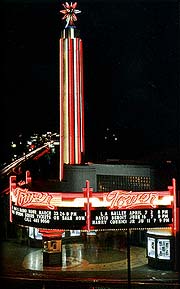TNT NEWS | SCREENING ROOM
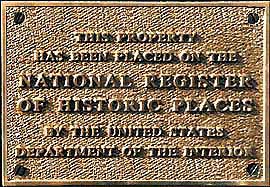 The Tower Theatre in Fresno, California
is located on the corner of North Wishon and East Olive, in the heart of the historic
arts & entertainment mecca of Central California. The original Tower was originally
a Fox Theatre when it opened in fateful 1939. The dramatic architectural featured
backlighted etched green glass panels, and sculptured aluminum fittings throughout
its art deco presence. This building is completely restored and is the
only 1930's suburban theater extant designed by Los Angeles architect S. Charles
Lee (1899-1990).
The Tower Theatre in Fresno, California
is located on the corner of North Wishon and East Olive, in the heart of the historic
arts & entertainment mecca of Central California. The original Tower was originally
a Fox Theatre when it opened in fateful 1939. The dramatic architectural featured
backlighted etched green glass panels, and sculptured aluminum fittings throughout
its art deco presence. This building is completely restored and is the
only 1930's suburban theater extant designed by Los Angeles architect S. Charles
Lee (1899-1990).
This theatre has an enormous paved parking lot and building boasting more than 20,000 square feet. The structure was described by Lee consisting of multilevel steel-reinforced concrete arrowhead-shaped patterns. Its central auditorium is situated on a 45 degree axis to the South facing entrance. Two retail wings accentuate the central auditorium. Each without ostentation being set-off with fitted painted wood casements, large storefront windows, French doors and old-style overhead transoms. Elegant cobalt blue ceramic tile work traces the store entrances which are protected from sun and rain by retractable merchant canvas awnings. At the Tower Theater's Box Office and exterior Lobby, an 80' fluted prominence rises dramatically over the surrounding business and residential mixed-use zone. At night,the lighted tower]s fittings of linear neon tube lighting, is crowned by a radiant multi-colored globe. The light show is reminiscent of 1939 New York World's Fair exhibits.
The bas-relief etched-glass panel created by Carvarts of Los Angeles is at the center of the entrance lobby. It is a magnificent representation entitled 'The Huntsman' a nearly identical knockoff of the 1927 glass sculpture by Gaetano Cecere (1894-1985). Authentication of the panel has been inconclusive, however.
Local architectural historians have accredited Heinsbergen's assistants, brothers Tom and Frank Bouman, for the final installation of the Tower Theatre murals, and actually painting them at night by blacklight to assure that they would achieve the proper fluorescent effects. The glory days of the past behind it, the Tower Theatre building now functions again as a community meeting place for performing arts and lectures. Summer film festivals have been proposed. Historical Significance A high-profile private-sector venture during the late Depression, the Tower Theatre was designed by S. Charles Lee and built by Trewhitt, Shields & Fisher, major Central San Joaquin Valley general contractors, at a cost of $100,000. It was the largest and most sophisticated privately-funded commercial building designed in that style at that time in Fresno. Rushed into occupancy before Christmas of 1939, the building was not issued a final certificate of completion until January 29, 1940. The Tower Theatre opened with a premier showing of the film 'Balalaika' for a private party of local dignitaries, Fox Theater executives and guests on December 14, 1939. Co-hosts for the event were developer and owner A. Emory Wishon (1882-1948) of San Francisco, a prominent California hydroelectric executive, and Charles P. Skoura of Los Angeles, president of Fox West Coast Theaters. The theater opened its doors to the film-viewing public on December 15, 1939. The double feature program included 'Dancing Coed' and 'Henry Goes Arizona.' The Tower Theatre is noted for being one of several
suburban theater designs that S. Charles Lee devised to show film industry
executives a new look in commercial movie theaters." It was profiled
shortly after its completion in a lavishly illustrated article in Motion
Picture Herald.
As Fresno's first suburban cinema, The Tower Theatre became the dominant vertical landmark anchoring a loosely-knit collection of shops that had been developing into a lively shopping area since 1923. The 'Tower District' as the area became known, provided several retail establishments and acres of free parking, including the theater's own on-site parking lot. Two miles north of downtown Fresno, the Tower District was located just a few short blocks from Fresno High School and Fresno State College, at the center of a growing residential section of town. With so many basic services nearby, area residents and students no longer needed to rely on shops and attractions downtown, where parking was difficult. A complete restoration of the exterior facade, ongoing tenant improvements in the retail wings and modifications to allow the adaptive reuse of the theater auditorium for the performing arts have brought new life to the theater and to the Tower District, which has become a lively collection of restaurants, pubs, jazz clubs and antique shops, with the highly successful 'Tower Theatre for the Performing Arts' at its center. In 1991, the dramatic theater rehabilitation was honored with a California Preservation Foundation Award for Outstanding Achievement in Restoration, and an Award of Honor from the San Joaquin Chapter, American Institute of Architects. For more architectural history of other significant Fresno area buildings and human history take a close look at Supplementary Historic Building Survey by John Edward Powell with student assistant Michael J. McGuire.
|
©1984-2000
HTML Graphics by WebPortal Inc.
All rights reserved.
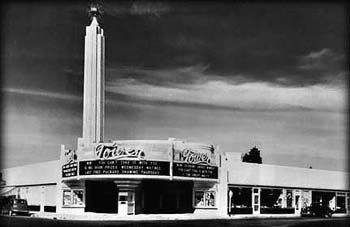 The Tower corner cantilevered marquee is balanced on a cleverly
situated Box Office with glazed windows and an automated ticket dispenser. Metallic
horizontal lines on ticket booth glazing, repeat through horizontal incantations
all about the exterior and interior of this Theatre. The outer lobby deck is a
multi-colored polished terrazzo radiating and emanating in a series of leaf patterns.
Ample poster cases surround the outer lobby and lead to three pairs of etched-glass
entry doors opening on to a lush carpeted foyer just inside.
The Tower corner cantilevered marquee is balanced on a cleverly
situated Box Office with glazed windows and an automated ticket dispenser. Metallic
horizontal lines on ticket booth glazing, repeat through horizontal incantations
all about the exterior and interior of this Theatre. The outer lobby deck is a
multi-colored polished terrazzo radiating and emanating in a series of leaf patterns.
Ample poster cases surround the outer lobby and lead to three pairs of etched-glass
entry doors opening on to a lush carpeted foyer just inside.
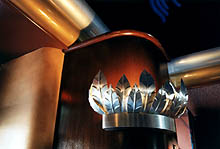 The
inner foyer is furnished in rich wood veneer, gold leaf and structural aluminum,
painted murals and blacklight. Theatre access doors leading into the theater auditorium
at each end are embellished. A mezzanine lounge provides access to restrooms rooms
and smoking areas.
The
inner foyer is furnished in rich wood veneer, gold leaf and structural aluminum,
painted murals and blacklight. Theatre access doors leading into the theater auditorium
at each end are embellished. A mezzanine lounge provides access to restrooms rooms
and smoking areas.
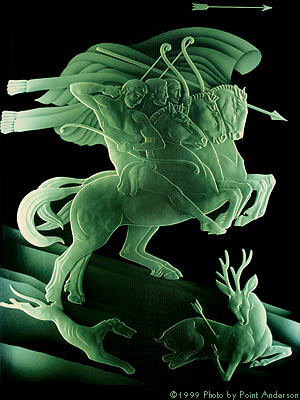 The
auditorium is rectilinear with a juxtaposed stage area at its center. Capable
of seating 900 movie goers at one setting, each side has three recessed areas
displaying circular murals that are positioned above decorative aluminum sculptured
sconces. The murals are stylized 'Leda and Swan' and 'Vine' motifs, painted with
fluorescent pigments. Illuminated by black light fixtures the murals and sconces
give off an erie light. This feature is one of the Tower Theatre's trademarks.
The mysterious glowing murals were the design of Netherlands muralist, Anthony
Heinsbergen (1895-1981). The blacklight innovations were credited to the genius
if R. H. McCullough and Walter Bantau.
The
auditorium is rectilinear with a juxtaposed stage area at its center. Capable
of seating 900 movie goers at one setting, each side has three recessed areas
displaying circular murals that are positioned above decorative aluminum sculptured
sconces. The murals are stylized 'Leda and Swan' and 'Vine' motifs, painted with
fluorescent pigments. Illuminated by black light fixtures the murals and sconces
give off an erie light. This feature is one of the Tower Theatre's trademarks.
The mysterious glowing murals were the design of Netherlands muralist, Anthony
Heinsbergen (1895-1981). The blacklight innovations were credited to the genius
if R. H. McCullough and Walter Bantau.
